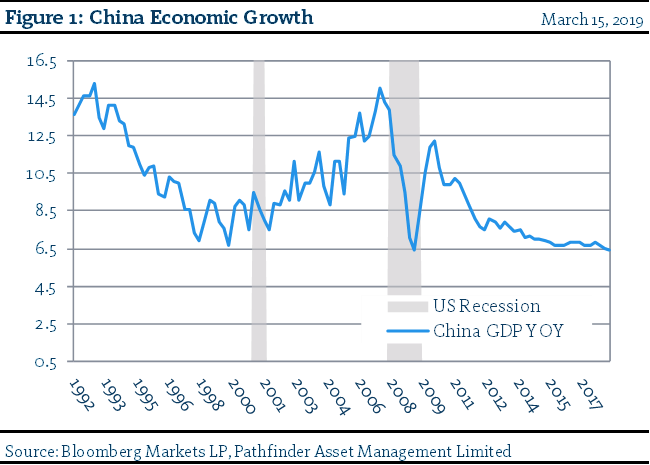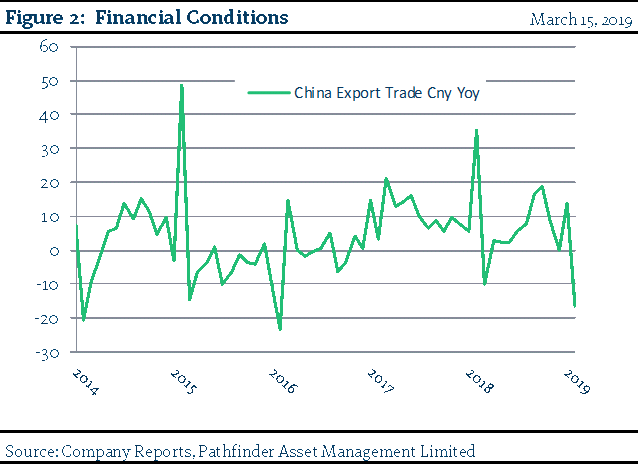Recap & Outlook: China Slowing
The second largest economy in the world is China. Although we live and work in Canada, because our economy is relatively small, we pay attention to the rest of the world. We regularly write about our view of the United States’ economy, which is the largest in the world. This week, we will write about China and next week Europe.
It is widely known that China has had, what many would describe, an economic miracle. The country has pulled hundreds of millions of people out of poverty. It has also grown a substantial middle class and is the second largest economy in the world. Since the early 2000s, growth has been very strong but more recently it has moderated. This has implications for the global economy and our portfolio companies.
- Figure 1 presents Gross Domestic Product (GDP) from the early 1990s. We have also added the two official US recessions for reference. As you can see from the fist recession, onward GDP has grown from 8.5% to as high as 15.0 in June of 2007. After the Great financial crisis, growth has moderated to a somewhat “stable” 6.5%. we use quotes with stable because many say GDP is either fabricated by the Chinese government or the economy is managed to target better than any in history.


- Recent reports that point to continued slowing have been released. Business sentiment, industrial production and power generation have all slowed. Exports have also dropped and this reflects slowing global growth and the impact of both US and Korean trade wars. To drive activity, late last year, The Bank of China reacted to the slowing economy with credit Earlier this year, it has tried again and initiated infrastructure stimulus.
“This means that” we continue to follow China closely. In some mandates we have taken the recent stock market weakness over the past 6 months as an opportunity to add to companies to our mandates that have significant revenue exposure to China and Asia in general. We believe China will be a strong growth center again in the future.
National Instrument 31-103 requires registered firms to disclose information that a reasonable investor would expect to know, including any material conflicts with the firm or its representatives. Doug Johnson and/or Pathfinder Asset Management Limited are an insider of companies periodically mentioned in this report. Please visit www.paml.ca for full disclosures.
*All returns are time weighted and net of investment management fees. Returns from the Pathfinder Partners’ Fund and Partners’ Real Return Plus Fund are presented based on the masters series of each fund. The Pathfinder Core: Equity Portfolio and The Pathfinder Core: High Income Portfolio are live accounts. These are actual accounts owned by the Pathfinder Chairman (Equity) and client (High Income) which contain no legacy positions, cash flows or other Pathfinder investment mandates or products. Monthly inception dates for each fund and portfolio are as follows: Pathfinder Core: Equity Portfolio (January 2011), Pathfinder Core: High Income Portfolio (October 2012) Partners’ Fund (April 2011), Partners’ Real Return Plus Fund (April, 2013), and Partners’ Core Plus Fund (November 2014).
Pathfinder Asset Management Limited (PAML) and its affiliates may collectively beneficially own in excess of 10% of one or more classes of the issued and outstanding equity securities mentioned in this newsletter. This publication is intended only to convey information. It is not to be construed as an investment guide or as an offer or solicitation of an offer to buy or sell any of the securities mentioned in it. The author has taken all usual and reasonable precautions to determine that the information contained in this publication has been obtained from sources believed to be reliable and that the procedures used to summarize and analyze such information are based on approved practices and principles in the investment industry. However, the market forces underlying investment value are subject to sudden and dramatic changes and data availability varies from one moment to the next. Consequently, neither the author nor PAML can make any warranty as to the accuracy or completeness of information, analysis or views contained in this publication or their usefulness or suitability in any particular circumstance. You should not undertake any investment or portfolio assessment or other transaction on the basis of this publication, but should first consult your portfolio manager, who can assess all relevant particulars of any proposed investment or transaction. PAML and the author accept no liability of any kind whatsoever or any damages or losses incurred by you as a result of reliance upon or use of this publication.